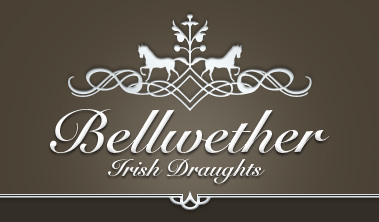|
About the Irish Draught
In the early part of the 20th century, the Irish farmer needed a more versatile horse than the popular heavy draft of the time. His horse was required to work the land during the week, fox hunt on Saturday and take the family to church on Sunday. It was from this need that the Irish Draught (pronounced draft') was born.
Careful breeding produced a horse that is very sound and sensible with good bone, substance and quality. Standing over a lot of ground, the Draught has an exceptionally strong and sound constitution, great stamina and a powerful jump. In addition, this breed possesses a fabulous temperament made up of willingness, intelligence, docility and common sense.
Not only is the Irish Draught a perfect companion mount for riders of all ages, but it possesses the ability and versatility to participate in various levels of jumping, eventing, dressage, hunting and driving. It is all these exceptional qualities that make the Irish Draught an invaluable and irreplaceable element in the production of the highly successful Irish Draught Sport Horse.
Type and Character
The Irish Draught Horse is an active, short-shinned, powerful horse with substance and quality. It is proud of bearing, deep of girth and strong of back and quarters. Standing over a lot of ground, it has an exceptionally strong and sound constitution. It has an intelligent and gentle nature and is noted for its docility and common sense.
Height
Stallions 15.3hh to 16.3hh approx.
Mares 15.1hh to 16.1hh approx.
Bone
Good, flat, strong, clean bone.
Head
Good, bold eyes set well apart, wide forehead and long, well-set ears. Head should be generous and pleasant, not coarse or hatchet headed, though a slight roman nose is permissible. The jawbones should have enough room to take the gullet and allow for ease of breathing.
Shoulders, Neck and Front
Shoulders should be clean-cut and not loaded, withers well defined, not coarse; the neck set in high and carried proudly, showing a good length of rein. The chest should not be too broad and beefy. The forearms should be long and muscular, not caught in at the elbows; the knee large and generous, set near the ground, and the cannon bone straight and short, with plenty of flat clean bone, and never back at the knee (calf-kneed) i.e. not sloping forward from knee to fetlock. The bone must not be round or coarse. The legs should be clean and hard with a little hair permissible at the back of the fetlock, as a necessary protection; the pasterns strong and in proportion, not short and upright nor long and weak. The hoof should be generous and sound, not boxy or contracted and there should be plenty of room at the heel.
Back, Hindquarters, Body and Hind Legs
The back is to be powerful, the girth very deep. The loins must not be weak but the mares must have enough room to carry a foal. The croup to buttocks is to be long and sloping, not short and rounded or flat-topped; hips not wide and plain. Thighs are strong and powerful and at least as wide from the back view as the hips, with the second thighs long and well-developed. The hocks are near the ground and generous, points not too close together or wide apart but straight; they should not be out behind the horse but should be in line from the back of the quarters to the heel to the ground; they should not be over bent or in any way weak. The cannon bone, etc. as for the foreleg should be short and strong.
Action
Smooth and free but without exaggeration and not heavy or ponderous. Walk and trot to be straight and true with good flexion of the hocks and freedom of the shoulders.
Color
Any strong whole color, including grays. White legs, above the knees or hocks not desirable. |



